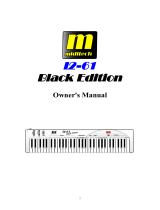
USB MIDI Master Keyboard
2
PRECAUTIONS
IMPORTANT
Always follow the basic precautions listed below to avoid the possibility of
serious injury or even death from electrical shock, damages, fire or other
hazards. These precautions include, but are not limited to, the follows:
1. Read and understand all the instructions.
2. Always follow the instructions on the instrument.
3.Before cleaning the instrument, always remove the electric plug from
the outlet as well as the USB cable. When cleaning, use a soft, dry cloth. Do
not use gasoline, alcohol, acetone, turps or any other organic solution; do
not use liquid cleaner or spray cleaner, or too wet cloth.
4. Do not use the instrument near water or moisture, such as bathtub,
washbasin, or washing poor in the kitchen, or similar places.
5. Do not place the instrument in an unstable position where it might acci-
dentally fall over.
6. Do not jam sinks or holes of the instrument; those sinks of holes are
used for air circulation to prevent the instrument from overheating. Do not
place the instrument near heat sink or any places with poor air circulation.
7. Always use the AC adaptor included with the instrument; do not use any
other AC adaptor.
8. Do not place anything on the power cord. Make sure the power cord is set
on a safe place, so nobody will step on it and no body will get trip over by it.
9. Do not overload the outlet and AC cable to avoid fire or electrical shock.
10. Do not insert anything in the instrument, which may cause fire or elec-
trical shock. Do not splash any kind of liquid to the instrument.
11. Do not disassemble the instrument in case of accidental electrical shock.
12. Always take the instrument to qualified service center in need of repair.
You will cause yourself in danger if you open or remove the cover, and im-
proper assembly may cause electrical shock in the future use.
13. Unplug all the connectors and take the instrument to qualified service
center if anything in the below list happens:
A. The power cord or connector get hurt or worn out.
B. Any liquid get in the instrument.
C. The instrument gets rain or water splash.
D. The instrument dose not work properly after following all the in-
structions regarding to troubleshooting.
E. The instrument falls down or gets broken.
F. The instrument functions poorly.
14. Do not use the instrument when thundering; otherwise the thundering
may cause long-distance electrical shock.
15. Do not use the
instrument when there is gas leak nearby.




















